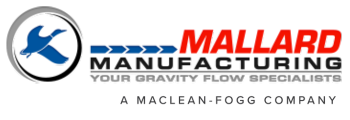Just the Right Pitch for Your Gravity Flow Rack | Mallard How-To
SOLUTIONS
FOR THE TOUGHEST APPLICATIONS
"*" indicates required fields
Use a New Angle to Get Your Lane Pitch Just Right
It will surprise no one to say that gravity flow rack uses the forces of gravity to move objects. To do that, flow rack mounts on an angle, or “pitch.” However, that pitch does more than just carry the inventory; it protects your pallet flow rack and your team. You see, too steep of a slope can wear down lane components, and too shallow a pitch can hang up pallets, causing inefficiencies. Either scenario can cause warehouse safety concerns. Getting the pitch just right is the goal of effective pallet flow lane design.
“Just a Slight Pitch”
We often hear that a lane needs “just a slight pitch” for a particular application. That is akin to saying just add a smidge of hot sauce to a recipe… My interpretation of a smidge could spell disaster at a family barbecue. Moreover, in a warehouse, the difference between a ⅜”, 7/16”, and ½” pitch may seem reasonably insignificant at first, but place that pitch on a long 30’ pallet flow lane with a 3000 lb. pallet on top, and you’ll see why the Mallard team deals in specifics and not undefined pitch levels.
Just the Right Pitch
The right pitch in gravity flow rack will move the pallet at a controlled speed and maintain tracking in the center of the lane vs. drifting to one side or the other. Speed controllers and lane guides will also help; however, the pitch is step one and crucial to the lane design success.
Setting the most effective pitch considers the length of the lane and the pallet load weight, but it isn’t as simple as it sounds. For example, the longer the lane, the higher the rise, and the heavier the pallet, the harder it is to control.
Gravity Flow Rack Rule of Thumb
 Single-height pallets –
Single-height pallets –
- Less than 3000 lbs. can typically flow on a pitch of 7/16” per foot; however, that is a starting point for your lane design. Speed controllers are often essential to maintain safe flow speed and center of the lane tracking.
- Pallets over 3000 lbs most often require a ⅜” per foot pitch and again speed controllers for safe, consistent flow.
- “Universal” pallet flow lanes – When designing a lane for various pallet load weights, use the heaviest pallet weight to configure the pitch. Note these pallet flow lanes are good candidates to test first due to the weight variance.
Stacked pallets – require a test in the Mallard in-house Engineering Testing Lab. There are often too many variables in stacked applications to ensure safe, productive operation without a test. Our tests produce definitive, comprehensive results.
Oversized loads – as with stacked pallets, oversized loads require a test to ensure the stability and safety of the load in the flow lane as well as the functionality of the pallet flow components.
Let Us Pitch In and Help
The Mallard team is available to help ensure your pallet flow rack design meets your inventory processing needs and warehouse safety goals. We conduct pallet flow tests nearly every day of the week, and we provide detailed videos and system configuration advice with each test. Call our gravity-flow experts to discuss your inventory storage needs or schedule a gravity-flow system test. Let’s put the power of gravity to work for you.
Visit our Request for Quote page for a prompt response: Pallet Flow RFQ.




